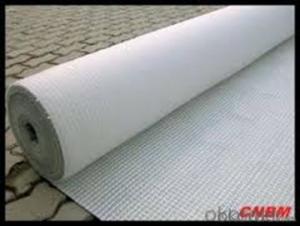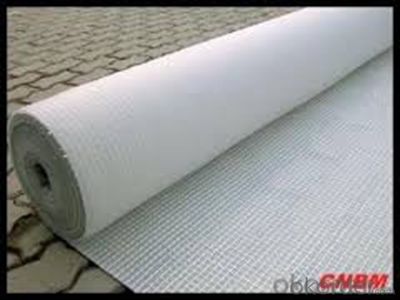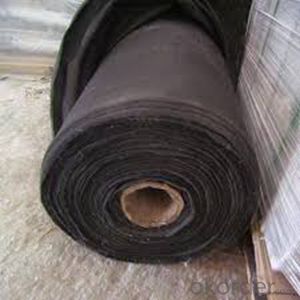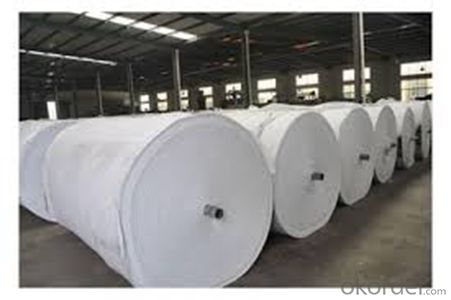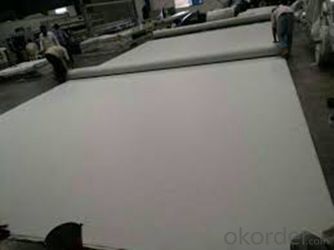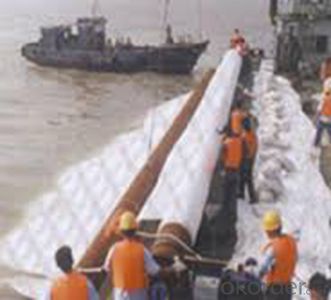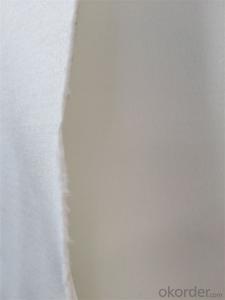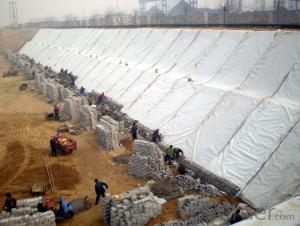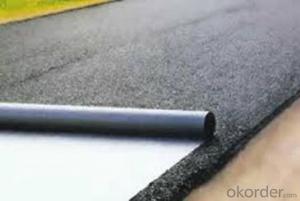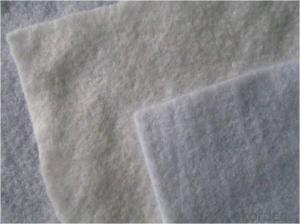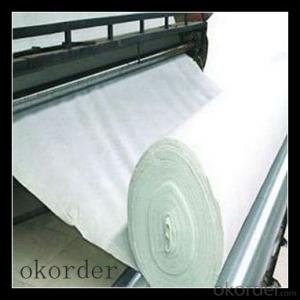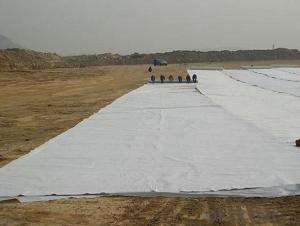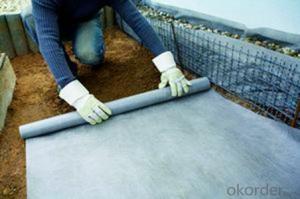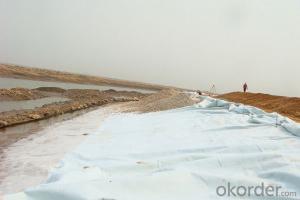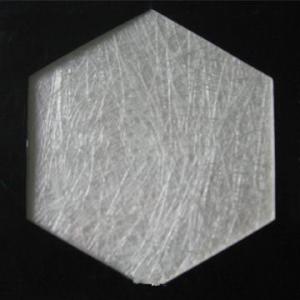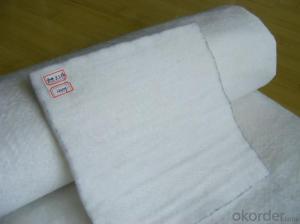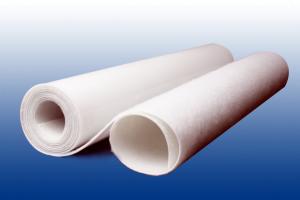Non-woven Filter Fabric Used in Road Construction from CNBM
- Loading Port:
- China main port
- Payment Terms:
- TT OR LC
- Min Order Qty:
- 1000 g/m²
- Supply Capability:
- 1000000 g/m²/month
OKorder Service Pledge
OKorder Financial Service
You Might Also Like
Specification
nonwoven geotextile 1.nonwoven geotextile 2.manufacturer 3.ISO9001:2008 4.good ability in filtration, separation, protect
filter fabric used in road construction Specification
SNG100g-SNG1500g/m2
filter fabric used in road construction Geotextile Property:
Good flexibility, permeability, filtration, separation and convenient for construction.
filter fabric used in road construction Usage:
Used in highway, railway, DAMS, reclamation for filtration, separation drainage and protection.
Product detail show :
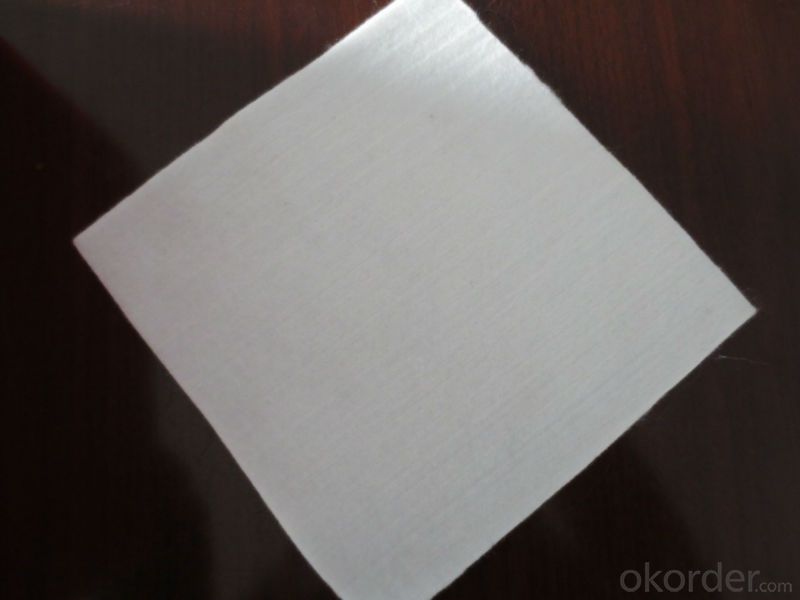
filter fabric used in road construction Size of Package:
Width 2-8 m, length 50-100 m (or at the request)
Products description:
The raw materials of geotextile are staple fibre, synthetic staple fibres, polypropylene.
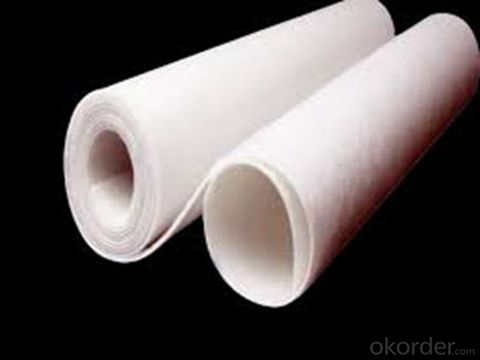
1.On a regular basis or as per your request,we entrust national testing agencies to conduct quality inspections
2. Strictly in accordance with the ISO9001-2008 international quality system standard,we monitor and manage the whole process throughout production,quality testing,and measurement to ensure product quality
3. For quality-related construction delay or substandard construction(except for damage or losses due to customer’s responsibility or irresistible natural disasters),we have refunding,replacement,and repair services.We will respond to customers’ feedbacks on quality issues within 24 hours.
After-sales service
1.In order to provide customers with comprehensive technical support,we will provide technical and other related information upon request in a timely manner.
2.In required,we will appoint specialized technicians to the construction site to give technical trainings to construction people,and offer technical guidance throughout the whole construction process.
3.For damage due to shipment and delivery,after we receive the complaint,we will check the issure through provided pictures and videos.If our responsibility is confirmed,we wil offer free replacement.
4.When the construction is completed,as your request,our technical staff may participate in the final acceptance.
FAQ:
Q: What kind of payments does jenor support?
A: T/T, L/C, Cash are accepted.
Q: Do you charge for the samples?
A: Accordeing to our company policy, the samples are free, we only charge the freight fee. And we will return the freight fee during the next order.
Q: Can you produce according to customers' design?
A: Sure, we are professional manufacturer, OEM and ODM are both welcome.
Q: Do you have other products?
A: Yes, please check the pictures:
- Q: How do geotextiles improve the performance of geofabrics?
- Geotextiles improve the performance of geofabrics by providing added strength, stability, and filtration capabilities. They act as a separator, preventing the mixing of different soil layers while allowing water to pass through. Geotextiles also reinforce the geofabrics, enhancing their load-bearing capacity and preventing soil erosion. Overall, geotextiles enhance the durability and effectiveness of geofabrics in various civil engineering and environmental applications.
- Q: Will you master knitting reinforced geotextile H and reinforced geotextile What is the difference? In addition, how to distinguish between spunbond and weaving in reinforced geotextiles? More
- Texture and material ratio is different ah.
- Q: What are the considerations for geotextile selection in mining operations?
- When selecting geotextiles for mining operations, several key considerations should be taken into account. These include the specific requirements of the mining site, such as the type of minerals being mined and the environmental conditions present. The geotextile's strength and durability are crucial factors, as it needs to withstand the heavy loads and harsh conditions associated with mining activities. Additionally, the geotextile's filtration properties and permeability should be assessed, as they play a vital role in controlling water flow and preventing soil erosion. Compatibility with other materials and the cost-effectiveness of the geotextile should also be considered during the selection process. Overall, choosing the right geotextile for mining operations requires a comprehensive evaluation of the site's unique characteristics and performance requirements.
- Q: How do geotextiles affect soil compaction?
- Geotextiles can help reduce soil compaction by providing a barrier between the soil and external forces. They distribute the load evenly, preventing the soil particles from being compressed too much. This allows the soil to maintain its natural structure and porosity, resulting in improved drainage and increased resistance to compaction.
- Q: In ANSYS, geotextile what unit to simulate it?
- The use of shell units is relatively more reasonable.
- Q: What are the different geotextile reinforcement techniques?
- Some of the different geotextile reinforcement techniques include geotextile fabrics, geogrids, geocells, and geocomposites. Geotextile fabrics are permeable fabrics made from synthetic materials and are used to stabilize soil and prevent erosion. Geogrids are high-strength materials that are used to enhance the stability of soil by providing tensile reinforcement. Geocells are three-dimensional honeycomb-like structures made from geotextile materials and are used for soil stabilization and erosion control. Geocomposites are combination products that consist of different geotextile materials and are used for various reinforcement applications, such as drainage, filtration, and separation.
- Q: Garage top back to the soil before the drainage board geotextile take what role
- The top surface of the drainage board glue a layer of geotextile filter to prevent the passage of soil particles, so as to avoid drainage channel obstruction of the drainage channel, said white is to do a filter layer, the water discharged to the designated location, the traditional process is Block ah, stone ah, what do the water layer, and now with the drainage board is not the reason for the stone is the drainage board is plastic, light weight, can reduce the load of the building. Manufacturers of drainage board geotextile waterproof board
- Q: Waterproof geotextile how much money per square meter
- This material has a lot of different quality, there are many different requirements, the price from dozens of pieces to more than 100 pieces between.
- Q: Geotextile moisture-proof layer: 200 cloth +400 film +200 cloth
- Two cloth a film manufacturers direct production qualification need to contact
- Q: How do geotextiles help in stabilizing slopes?
- Geotextiles help in stabilizing slopes by providing reinforcement and erosion control. They are placed between soil layers to enhance their strength and prevent soil movement. Geotextiles act as a barrier, distributing the load over a wider area and reducing the risk of slope failure. Additionally, they promote drainage and filtration, preventing the accumulation of water that can weaken the soil and lead to erosion.
Send your message to us
Non-woven Filter Fabric Used in Road Construction from CNBM
- Loading Port:
- China main port
- Payment Terms:
- TT OR LC
- Min Order Qty:
- 1000 g/m²
- Supply Capability:
- 1000000 g/m²/month
OKorder Service Pledge
OKorder Financial Service
Similar products
Hot products
Hot Searches
Related keywords
